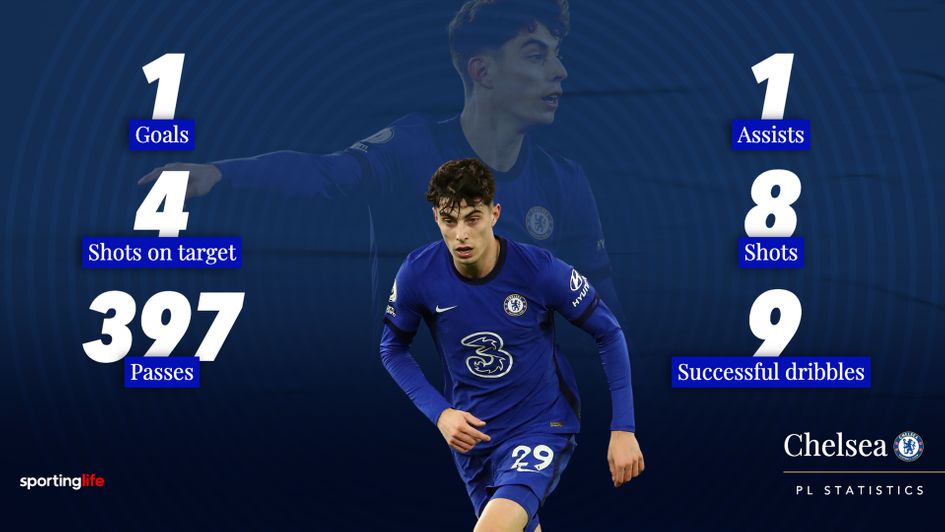Kai Havertz is Real Madrid’s latest Galactico. Timo Werner is Liverpool’s big buy, the long-term successor to one of Jurgen Klopp’s feared front three.
It is an alternative scenario: had 2020 not wreaked such havoc on football finances, each might be found somewhere else now as someone else’s flagship summer buy. Instead, Roman Abramovich used his wealth to take advantage of others’ sudden inability to meet asking prices. Chelsea acquired the men who, it seemed, half of the European elite coveted.
And now there is a case to be made that neither figures in Chelsea’s strongest side.
The stats included in this article are correct at the time of publishing, before Arsenal v Chelsea on 26/12/20
Why is Timo Werner struggling at Chelsea?

Look at £48m Werner: Olivier Giroud and Tammy Abraham are in their own private competition to lead the line.
Werner was shifted to the left, which had a certain logic in that he often ended up in the inside-left channel when partnering the target man Yussuf Poulsen in Germany, but that was where Christian Pulisic offered hints of Eden Hazard in the summer.
When fit, Hakim Ziyech looks both the best and most natural choice on the right. It is only Werner’s third best position.
Havertz meanwhile, who cost Chelsea almost £30m more than his Germany team-mate, is the No. 10 in a team who do not play with a No. 10. If the thought was that his arrival could prompt a switch to 4-2-3-1, it appears mistaken. Frank Lampard’s preference for 4-3-3 has remained with different personnel.
His versatility has felt more burden than blessing: he was miscast as a right winger on his debut at Brighton, and as a false nine in his home bow against Liverpool. As a No. 8, he has been outshone by Mason Mount, the local who has responded to Havertz’s arrival by raising his game. Mateo Kovacic, an influential substitute in Monday's 3-0 win over West Ham, may be a more compelling choice.
There are mitigating factors: Havertz was rusty when he arrived, with the deal delayed by negotiations. He was improving when sidelined by Covid-19, which hit him hard. Yet his maiden Premier League campaign has brought a solitary goal and assist so far; after mediocre displays against Everton, on the right, and Wolves, in midfield, he was relegated to the bench against West Ham.
Werner, with four goals and four assists, has been more productive, but he has not scored in 10 outings in all competitions, a run that began with Germany’s 6-0 shellacking by Spain; Lampard has denied it left psychological scars, but the on-field evidence suggests otherwise.
Werner finished second only to Robert Lewandowski in the Bundesliga scoring charts last season, with 28.
Now he is third in a very different table - for big chances missed. His eight is ‘bettered’ only by Patrick Bamford and Chris Wood. The biggest of all, the open goal he missed against Leeds, had an Expected Goals (xG) of 0.89.
🤔 Miss of the....
— Sporting Life Football (@SportingLifeFC) December 5, 2020
A) Day
B) Season
C) History of footballpic.twitter.com/soX2gOF71p
Profligacy explains Werner's diminishing return. His 0.48 xG per 90 minutes is 50% down on 0.72 for RB Leipzig.
But he overperformed his xG by 5.7 then and has underperformed it by 2.4 for Chelsea. His goals-per-90 minutes, of 0.30, is his lowest since he was a teenager for relegated Stuttgart.
He is having fewer shots – 2.69 every 90 minutes, compared to 3.77 – but with fewer on target, the ratio dropping from 50% to 44% even though the average distance of his efforts is marginally closer.
The most dramatic difference lies in his chance conversion rate: 21% last season, 11% this. Now Abraham is the forward scoring from 21% of his shots while Giroud (4.03 shots per 90 minutes) is the most persistent threat.
Werner has become slightly more creative, averaging 0.30 assists per 90 minutes, compared to around 0.25 across the past three seasons; that can be attributed to his wider role. It also reflects on others’ fine finishing; his expected assists per 90 minutes is 0.17, though that puts him on a par with Pulisic, who is on 0.15 this season and 0.18 last.
What is Kai Havertz's best position?

It puts both far above Havertz. It is notable all the former Leverkusen man’s Premier League and Champions League goals and assists have come as a No. 10 or a No. 8. Yet overall his return of 0.08 expected assists per 90 Premier League minutes – or one every 12 full games – puts him only 13th in the Chelsea squad.
Havertz figures eighth for shot-creating actions, below Kovacic and far behind Mount. His average of 2.81 is more than 50% down on 4.33 last season, and his 0.8 key passes per game is far behind Mount’s 2.1. Nor is he as involved in general play: his return of 33 passes per game compares unfavourably with the Englishman’s 48 and, indeed, his own 45 last season.
Mount’s greater intensity is reflected in their defensive contributions – 32 tackles to 13, 66 successful pressures to 31, 14 interceptions to five – to an extent that is not fully explained by the difference in minutes played.
The most notable difference is in front of goal; while he operated further forward in the Bundesliga, including a stint in summer as a false nine, Havertz averaged 2.64 shots per 90 minutes in 2018-19, 2.13 in 2019-20 and now only 1.05.
His record in his homeland, where he scored 29 league goals in his final two seasons, suggested he could become the Premier League’s most potent attacking midfielder, a mantle that once rested with his manager.
Now Lampard has to determine if Chelsea are better off with Havertz on the bench.
The stats included in this article are correct at the time of publishing, before Arsenal v Chelsea on 26/12/20







